The SABR 52 Convention in Minneapolis
Notes, photos, links, and more from the Society for American Baseball Research's 52nd annual convention, held earlier this month in Minneapolis, Minnesota
Issue #193
NOTE: this is a lengthy article, so if you are reading it as an email, you may need to click the title link to view the entire article on the Substack website.
A couple of weeks ago, from August 7-10 , I attended the 52nd Convention for SABR, the Society for American Baseball Research. I’ve been a member of SABR for many years, off and on since the 1990s, and this was my fourth consecutive annual convention (2019, 2022, 2023, 2024, since we didn’t have one in 2020 or 2021).
As I did for the last two conventions, I’ve wanted to do a write-up about my experience at the event, including notes from some sessions I attended, a few pics, etc. I got delayed by other projects, but here it is! Of course this is just one person’s experience, a small slice of the overall event—but for SABR members or other baseball fans who could not attend, I hope you enjoy this recap.
Over 500 SABR members and other baseball fans gathered at the Hyatt Regency in Minneapolis, Minnesota. The convention included a great schedule packed with:
A loaded lineup of outstanding speakers and panels, including some star appearances by Hall of Famers Tony Oliva, Rod Carew, Bert Blyleven, and Jim Kaat
Fresh new research on many aspects of the game, including history, analytics, and more
Over two dozen SABR committee meetings (see list of the committees), on a wide range of topics
A poster-session area with about a dozen research "posters," each with loads of detail on interesting baseball research topics
A special film screening of The Diamond King, a new biopic on the career of legendary baseball artist Dick Perez with filmmaker Marq Evans.
A baseball card pack-opening extravaganza hosted by the SABR Baseball Card committee (I assisted committee co-chair Jason Schwartz by playing Santa and distributing hundreds of packs to the 50+ people who participated!)
An exhibitors room for book publishers, authors, and vendors and service providers to demo and sell their wares
Also included was the choice between a Target Field Tour and a St. Paul Saints minor league game, a SABR donors breakfast, an awards closing session, and a Friday night Cleveland Guardians vs. Minnesota Twins game at Target Field, which the hometown Twins won 6-3.
No single article can capture all of the presentations and other components of the convention. But below are my notes from some of the sessions I attended.
Opening Remarks - Derek Falvey - President of Baseball Operations for the Minnesota Twins
Falvey shared his background with baseball, starting with the passion has grandfather and father had for the game while he grew up in the Boston area. He played baseball through high school and a bit in Division III at Trinity college. He then spent a summer as an unpaid amateur scout for players in the Cape Code League, and that passion led to an opportunity to join in a starter job with Cleveland Indians.
He was with Cleveland in front office roles for nine years before joining the Twins organization in 2016. During his time in Cleveland, he came to understand the brilliance of Terry Francona, who he sees as one of the few baseball leaders who has really spanned the integration of historical/traditional approaches to player evaluation and development, while also moving forward with modern analytics, Statcast data, and so on. Falvey aligned with this approach to baseball, admitting that he isn't the smartest in the game regarding traditional scouting, nor the smartest regarding modern analytics--but he likes serving as a bridge between these two aspects.
This perspective and approach have guided him in his role with Minnesota, and the Twins have certainly seen success during this period: since he joined in October 2016, the Twins have won three AL Central Division titles and qualified for four postseasons. The team also set a single season team HR record with 307 HR in 2019 when they won 101 games.
When asked during the Q&A about the use of data and analytics in player drafting and development, Falvey emphasized the increasing importance of personalization in player development as a competitive advantage. He noted that having a certain level of evaluative analytics is now effectively table stakes across the league (with some variation of course). A differentiator going forward will be the use of analytics to truly personalize development programs for after a player is drafted or otherwise acquired. Each player is different, so optimizing their productivity requires a very personalized approach.
Falvey noted during the Q&A that humility is very important in baseball. Perhaps more than any other sport, anything and everything can and does happen: as a baseball player you were either just humbled or you are about to be humbled.
One Q&A participant asked Falvey if Twins OF Byron Buxton has been injured again in the past 24 hours--the answer, as far as he knew, was no (ha!).
Panel Sessions
Hitters Panel with Rod Carew and Tony Oliva
Tony Oliva is now 86 years old, Rod Carew is 78. It was a pleasure to listen to them share stories and perspectives from their long careers in the game, as players and in retirement.
Carew remembered that when he first came to the big leagues, he said to his wife that he noticed Tony Oliva was winning batting titles--and that he planned to do the same, and surpass him. He went on to win seven AL batting titles.
Carew said after two years in the minors he threatened to "go on strike" rather than play in the minors again. That was in early spring of 1967, and he instead was the Twins 2B that year. He was an All-Star as a rookie, the first of an amazing 18 consecutive AL All-Star team selections.
Carew and Oliva were roommates for 11 years. While Carew did win more batting titles compared to Oliva's three, interestingly Oliva more often led the AL in hits, with five hit titles vs. only three for Carew.
Both Oliva and Carew won AL Rookie of the Year honors, Oliva in 1964 and Carew in 1967. Oliva's rookie campaign in particular was outstanding: in 161 games he led the league with 109 runs, 217 hits, 43 doubles, and a .323 batting average. He also hit 32 HR with 94 RBI--those 32 homers would end up being his career high. Like Carew, Oliva was an All-Star in his rookie season, and similarly that started a consecutive All-Star game streak, in his case spanning 8 seasons through 1971.
Carew noted that he just had a knee operation a month ago. Having been through that, he marveled at how Tony played with so much knee pain over the years--during which time he had seven knee operations.
Carew said he was given advice from Harmon Killebrew regarding fan interaction--whenever you sign an autograph, do the fan a favor and make sure they can read your name. And that was coming from a player with a much longer name!
Carew lamented some aspects of the modern game, such as the Manfred Man in extra innings, but also the amount of strikeouts in the game and the lack of shame that hitters feel when they strikeout as much as they do. Both Oliva and Carew said they wished current ballplayers would spend as much time on the mental aspects of the game as they do the physical. Oliva in particular spoke on the need for players to leave distractions (such as computers, social media, etc.) aside and focus more on watching every second of the game to learn from that action before they go back on the field.
Both Carew and Oliva could hit Hall of Famer Catfish Hunter very well. Carew told a story of how once he told catcher Thurman Munson that he was going to call out each pitch from Hunter as they were coming in. Because of his history of focus and note-taking on each pitcher, he was able to do exactly that: first a fastball low and inside and then a slider low and away. Munson then said he and Hunter were going to hit him with the next pitch, and Carew said "no you won't… fastball low and away… double down the LF line". And that is exactly what happened.
Pitchers Panel with Hall of Famers Bert Blyleven and Jim Kaat, as well as former major leaguers LaTroy Hawkins and Glen Perkins
Between them, these four pitchers pitched in the major leagues spanning an era from 1959 to 2017. It was also noted that between them they owned 16 Gold Glove Awards, albeit all of them owned by Jim Kaat.
Perkins noted that he got his slider grip from Joe Nathan, in response to his pitching coach telling Perkins' that his curveball stinks. For most of his career, development of pitches and pitching techniques were still done the traditional way, as he retired by 2017 at the age of 34--just as technology and other aspects of the game were rapidly changing. Hawkins agreed, noting he retired in 2015 and so also missed most of the advantages for pitch development that the modern technology and analytics provides.
Kaat was once confronted by the assertion that by using pine tar he was using a foreign substance on the ball. His response: "No I'm not, it is produced in North Carolina."
Perkins noted that when he was playing, the mantra was to throw fastballs down in the zone all the time. However, he often had better success throwing high fastballs, as they'd produce more pop ups, strikeouts, etc.
Hawkins noted that today, in general, the pitchers are ahead of the hitters in terms of pitch development, bullpen construction and usage, and the ability to make adjustments quickly based on solid data.
Blyleven described the early days of his career, including how much he learned from Jim Kaat and other major leaguers. This included specific instruction he received from a coach on making better use of his legs and his core, which was critical to his eventual major league success.
Kaat said his preferred balance for ballplayers is for them to be data-informed, but not data-driven.
Perkins said that a coach once reminded him not to get too excited by a good bullpen session. In short, he said "I've seen a lot of no-hitters thrown in the bullpen."
Perkins and Hawkins noted that the value of paying attention to the in-game details, such as whether a hitter is creeping up in the box regularly, or only sometimes in the moment. Blyleven added the importance of reading the box scores, or today watching video clips, to learn who is seeing the ball well lately, etc.
Kaat noted that his career is more closely linked in time to Babe Ruth and Walter Johnson than today's players.
Hawkins and Perkins said they both loved the Metrodome, because you didn't have to worry about the weather, with the temperature always being ideal and no rain threat. That said, the weather in Minnesota is generally pretty good for most of the summer, so the current field is beautiful and good to play in as well.
Blyleven humorously said several times, in multiple contexts, "I don't like hitters."
Hawkins said that over the course of his long career, the biggest change he saw was with hitters: early in his career there were more spray hitters willing to hit to all fields and make adjustments, whereas by 2015 they were almost entirely focused on hitting homeruns.
For Kaat, the biggest change over his playing career was the introduction of free agency and the ability for players to have more self-determination, and ultimately earn more over time.
Umpire Panel
Emma Charlesworth-Seiler spent six seasons as a professional umpire including in the minor leagues and at spring training (both Florida and Arizona). She also was an umpire academy instructor for three years.
She described how intense "umpire school" is, full of drills, experiential testing, knowledge tests, etc.
Today she works with a non-profit organization called Level Ump that helps support women and other under-represented groups in the journey into baseball umpiring as a career.
Challenges of umpiring include being away from home for 6 months of the year, constantly travelling and living out of your suitcase in hotels. You need to be someone who loves travel.
The pay is better than it was before, but still only good for the 6 months you do it--as a minor league umpire you need an off-season job for 5-6 months, which can be hard to get year after year.
It is also a job that you do fully in the public, with people watching and constantly criticizing your work--few jobs are like that. When she started, she was also only one of two women--out of 235 minor league umpires. That number has increased today, but women are still very much a small minority (as they are in many baseball roles, e.g., coaches, trainers, etc.)
She also noted that when she started the uniforms and protective gear were made almost entirely for larger men, though today there is a clause in the collective agreement on this issue.
Jeff Nelson went to Umpire School in 1989, and was a major-league umpire for 26 years from 1997 to 2023. He called four World Series, nine League Championship Series, and two All-Stars Games during his professional career.
Jeff praised the hard work that Emma had to put in over the years to overcome the obvious challenges of her being a woman in a male-dominated field. He also lamented the lack of people of color as umpires over the years, especially in the minor leagues well into the 80s and 90s. Things have been improving, with many focused efforts to encourage and support women and people of color in the world of baseball umpiring.
He also noted that to some extent today there is a shortage of umpires, so increasingly there is a recruiting effort in the field, similar to how athletes are scouted and recruited.
Stew Thornley was an umpire for 40 years, and is now an official scorer. He said umpiring is a great pathway to becoming an official scorer, because you get critical experience in the game (especially the rules), being decisive, and taking crap from fans and critics!
He recommended the old Knotty Problems of Baseball series from the Sporting News, and the books that came out in many years, as a fascinating way to learn the rules of baseball, the details of difficult cases, and the history of rules changes over time.
During the Q&A, when asked who their favorite "good guys" were, Jeff said Joe Mauer and Tony Gwynn were both class acts as superstars, and also noted Brandon Inge from the Tigers was a great guy. Emma named a local Twins player, Royce Lewis, and also said Lance Parrish later in his career as a manager was very respectful towards managers.
When asked about robots replacing umpires, Emma said that yes, there are some aspects of the game that are black and white and can be reduced to ones and zeroes, but that most aspects cannot be and involve very nuanced decision making.
Minnesota Twins Analytics Panel
The panel included: Thad Levine, Senior Vice President and General Manager; Jeremy Rot or Raadt; Josh Kalk, Vice President, Baseball Operations Strategy and Innovation; Joshua Ruffin, Assistant Director, Player Development Research.
Levine and Ruffin both came to their careers after initially having dreams of being professional players, but early on realizing they weren't good enough players, so finding other ways to work in the game. Kalk was a physics professor before joining the Twins in this role after Statcast and related systems started providing vast amounts of data to consider.
The panel noted that their analytics tools are a mix of third party tools available to all teams, and many applications that they have developed in-house and that are proprietary.
Ruffin said that his biggest focus is on making the advanced analytics understandable for the coaches and players to best inform their decision making and play on the field. The insights can't be too complicated and data-rich, because that will be overwhelming--especially given the broad range of education level of baseball players.
To further this, the team has also embedded Spanish-speaking employees in key areas to help with communication for players from Latin America who are still learning English.
Ruffin said that there are aspects of a pitcher's development that are easier to change and others that are harder to improve. This is important in initially scouting of young players, and throughout the development process. That said, each player is a unique human being, and so development plans need to be very personalized.
The Twins see themselves as a small market, but a very progressive one when it comes to analytics. They are aware of what they do very well and what they don't do as well--and this can influence who they draft, above and beyond the surface-level stats.
When a player first joins the organization, they don't immediately dive into analytics-driven development with them. Rather, they let them be themselves for a bit--and see who comes to them asking for support first.
Analytics departments these days are very focused on what metrics are most predictive of success, drilling down into details beyond surface level outcome stats such as K/9, ERA, batting average, etc.
Additional interesting panels included (no notes taken):
Minnesota Black Baseball Panel: Pete Gorton, founder of The Donaldson Network; Frank M. White, historian and author; Todd Peterson, co-chair of SABR's Negro Leagues Committee; Carl Rogan, grandson of Hall of Famer Wilber "Bullet" Rogan.
Future of Baseball Broadcasts Panel: Dave St. Peter, President/CEO, Minnesota Twins; Rob Hubbard, President/CEO, Hubbard Television Group; Evan Drellich, Senior Writer, The Athletic. Moderator: Adam Platt, Executive Editor, Twin Cities Business.
Select Research Sessions
The Pitching Cycle: Definition and Achievers (1893-2023), by Herm Krabbenhoft
There have been 351 hitting cycles from 1876-2023.
What would a pitcher's cycle be? Herm landed on "The series of at least one payer from each of the 9 recurring batting slots (not necessarily in order) struck out by one pitcher in the same game."
Batters hit for their cycle, pitchers hurl for their cycle. Batters collect a certain set of hits, pitchers collect a certain set of strikeouts.
Herm's research found that there have been 483 pitcher's cycles by 276 different players from 1893-2023 (AL, NL, FL only -- he plans to cover the major Negro Leagues soon). He started with 1893 as that is when the pitcher's mound was moved to the current distance of 60 feet, six inches.
The first pitcher's cycle was by Noodles Hahn in 1901.
The first pitcher to achieve two or three pitcher's cycle was Christy Mathewson. He had the record until Sam Jones became the first pitcher to have four pitcher's cycles.
Sandy Koufax had five in his career, then Nolan Ryan eclipsed him and eventually had 11 pitcher's cycles. Randy Johnson tied that and kept going ending up with an impressive 21 pitcher's cycles for his career.
Where Did the 24 Minutes Go?, by David W. Smith
The average game time length in 2023 was 24 minutes lower and was the lowest since 1984.
Time consumed by pitching changes was significant, so changing the rule that now requires a pitcher to face three batters (unless inning ends or they get injured) definitely had an impact.
The pitching clock (and hitter clock) have been significant changes impacting the 24-minute decrease in game length. But other factors have been important too, such as the limit to only two pitcher disengagements per plate appearance (each throw over to first base takes 24 seconds).
From 2018 to 2023, on average, it now takes 3 seconds less for each next pitch within a plate appearance, with bases empty, and 6.7 seconds less when there are runners on base. This reduction accounts for 65% of the 24 minute overall game length reduction.
There has also been about a seven second reduction in time transitioning between batters. That accounts for 26% of the 24 minute reduction in game length.
Other factors have been changes in player ejections, replay challenges, relief pitcher substitutions (there have been fewer), mound visits (about 1.5 minutes less in 2023 vs. 2018), batter timeouts (interestingly, 13.2% of all plate appearances involve a batter timeout -- and more often these are after a swinging strike or a foul ball than a called strike).
During the Q&A, he noted that the change a while back to automate intentional walks only saved 35 seconds per game.
Ron Guidry When Billy Martin Managed vs. When Someone Else Managed, by Rick Solomon
Ron Guidry pitched his entire career for the New York Yankees. Billy Martin managed him for three full seasons, and parts of several others. These times were sprinkled throughout his career, so in analyzing how well Guidry did under different managers, this spread helps to guard against any difference being more the result of the years involved (early or late in career).
The suspicion / hypothesis was that Guidry's statistics were better when Martin was manager vs. when he was not.
Indeed Guidry's ERA was 3.07 with Martin at the helm vs. 3.45 when others managed. His W-L record was even more dramatically better with Martin: 84-26 vs. 86-65.
Rick talked to Willie Randolph and he agreed this difference is impressive. He didn't really know why it would happen, but he noted that baseball is a "game of rhythm," and being comfortable with many factors can play a role in performance.
One potential factor here is that four of the five times Martin managed the Yankees during Guidry's career, Art Fowler was the Yankees pitching coach. Guidry's autobiography did note that he received good, simple advice from Fowler, and he also appreciated his sense of humor.
Another factor is that from 1975-1988 the Yankees overall record was better (.591) with Martin as manager than without him as manager (.548). Guidry doing better with Martin would only be part of that difference.
In Guidry's autobiography it was said that trust was slow to build between Martin and Guidry, but it did build over their first few years together.
After several attempts, Rick was able to get a hold of Guidry to discuss his research with him. He confirmed that yes, he appreciated Art Fowler as a pitching coach, and that yes, they had established a lot of trust over the years. Overall, he considered Martin to be his "best manager."
Who Scored Baseball's One Millionth Run, by Mark Armour
In 1975 it was determined by a researcher that about 2,000 more runs were needed to reach 1,000,000 historical AL/NL runs.
Bob Watson, May 4, 1975 was declared as the guy who did it.
Armour has found that through 1974 there were 998,040 runs, which is 171 more than had been determined -- not because any mistakes had been made, but because the statistics have been adjusted/corrected over the years since. In short, +183 net change in 19th century, -12 runs net change in 20th century, is what accounts for the difference
So the revised 1,000,000th run came on May 2, 1975, which is 171 runs prior to Bob Watson's celebrated run.
Larry Bowa and Willie Montanez scored on the same play in a game that day, via a base hit by Jay Johnstone. But it was Montanez' run that according to Armour's interesting and detailed research, was -- as of now -- the most likely 1,000,000th run in AL/NL history.
A caveat is that, according to Retrosheet, there are hundreds of games since 1901 with "discrepancies" where there is uncertainty, and surely in some cases errors, in game data, including sometimes runs data.
As a result, Pete Palmer is no doubt correct when he said "No one will ever know when the millionth run was scored. Baseball data isn't that accurate."
The Position, the Whole Position, and Nothing but the Position, by Neal Traven
Research for this project used Lahman Baseball Database, as well as baseball-reference.com.
One can easily look up who played the most games in baseball, and also who played the most at each position.
But who played the most games at each position--while only ever playing in the majors at that one position? For instance, Ivan Rodriguez played 2,427 games at Catcher… but also played 8 games at 1B and 1 game at 2B. So who played the most games at catcher while never playing another position in the field? (games at DH, or as a pinch-hitter or pinch-runner do not count, as those aren't position in the field.)
The answers according to Traven's research are interesting:
P - Mike Stanton - 1,178
C - A.J. Pierzynski - 1,936
1B - Fred McGriff - 2,239
2B - Lou Whitaker - 2,306
3B - Scott Rolen - 2,023
SS - Derek Jeter - 2,674
LF - Khris Davis - 503
CF - Brian McRae - 1,307
RF - Harry Lumley - 700
SP - Glavine - 682
RP - John Franco - 1,119
OF - Barry Bonds - 2,874
Two Events at Target Field
Target Field Group Tour
Several groups of SABR convention attendees were given tours of the Twin's home Target Field. These were lengthy, detailed tours, and included the field level and dugout, the press area, various behind the scenes area, and even the Twins clubhouse (the only part of the tour where photos were not allowed). I was impressed by just how many pairs of shoes/cleats the players have in their lockers--one or two dozen each! Here are a few photos I took on the tour:
Guardians-Twins Game on Friday, August 9th
Lastly, below is the view from our SABR group’s seats for the Guardians/Twins game at Target Field on Friday, August 9th, which the Twins won 6-3.
Links for more SABR 52 information
There are many links to highlights from SABR 52 from SABR’s main convention webpage. They are also several SABR convention photo galleries as well.
It was announced that next year's SABR 53 convention will be held June 25-29, 2025, in Dallas/Fort Worth, Texas.
Did you know? I wrote a book with the same title as this Substack newsletter / blog: Now Taking the Field: Baseball’s All-Time Dream Teams for All 30 Franchises. It was published in early 2019, by ACTA Sports, the publisher of the annual Bill James Handbook and other popular titles. You can learn more about it at www.NowTakingTheField.com, or buy directly at Amazon and other booksellers.




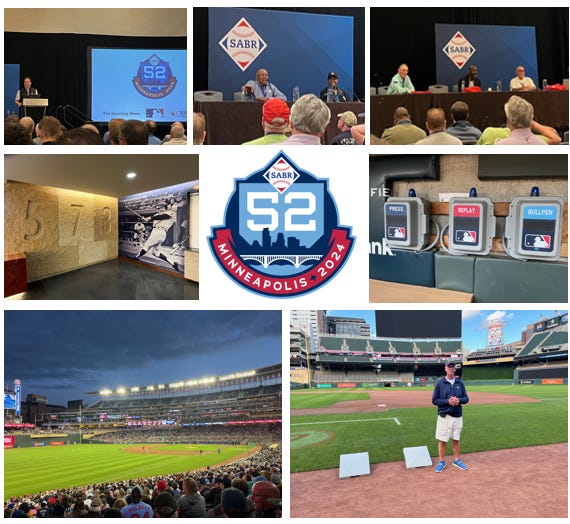
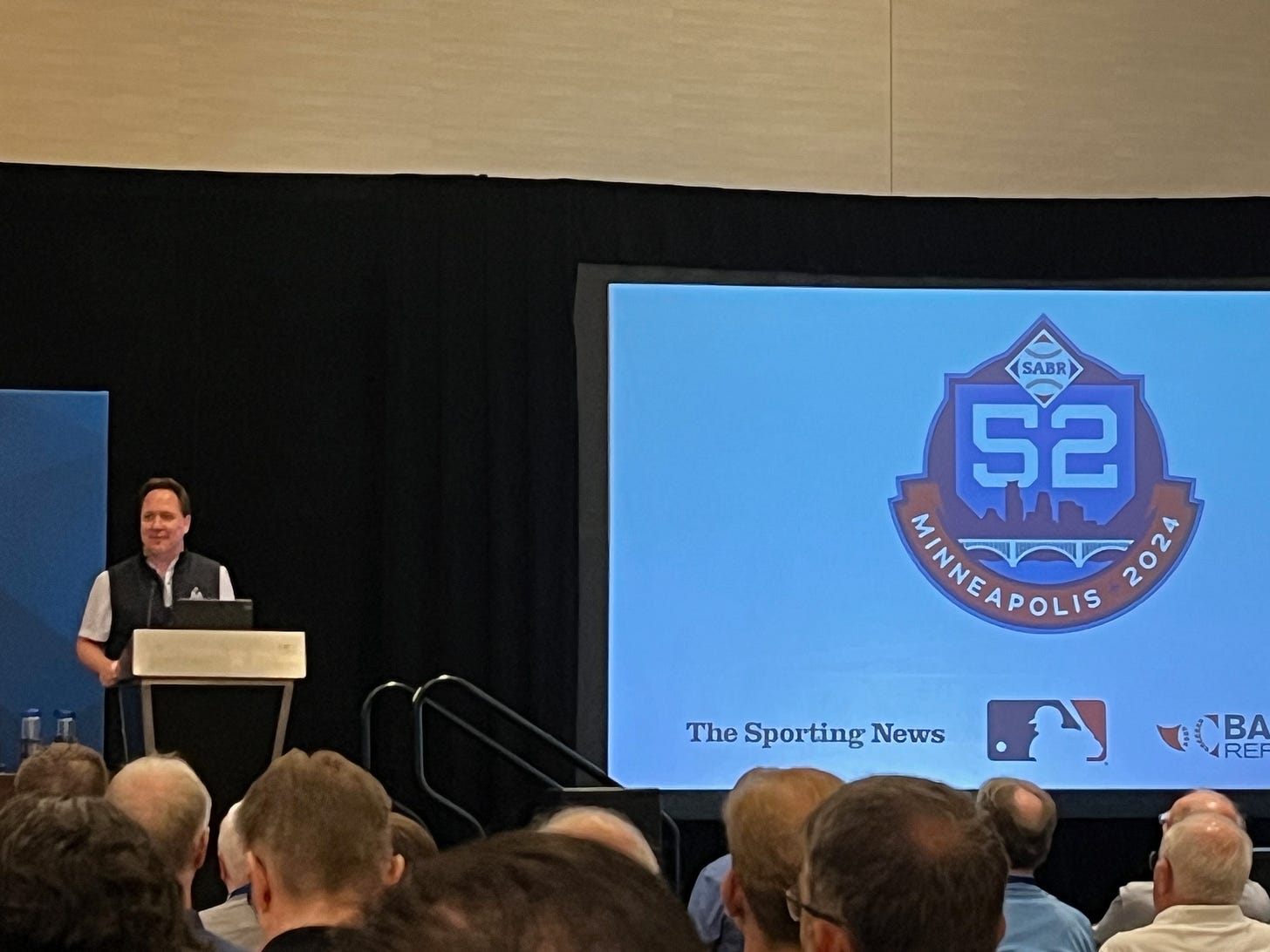
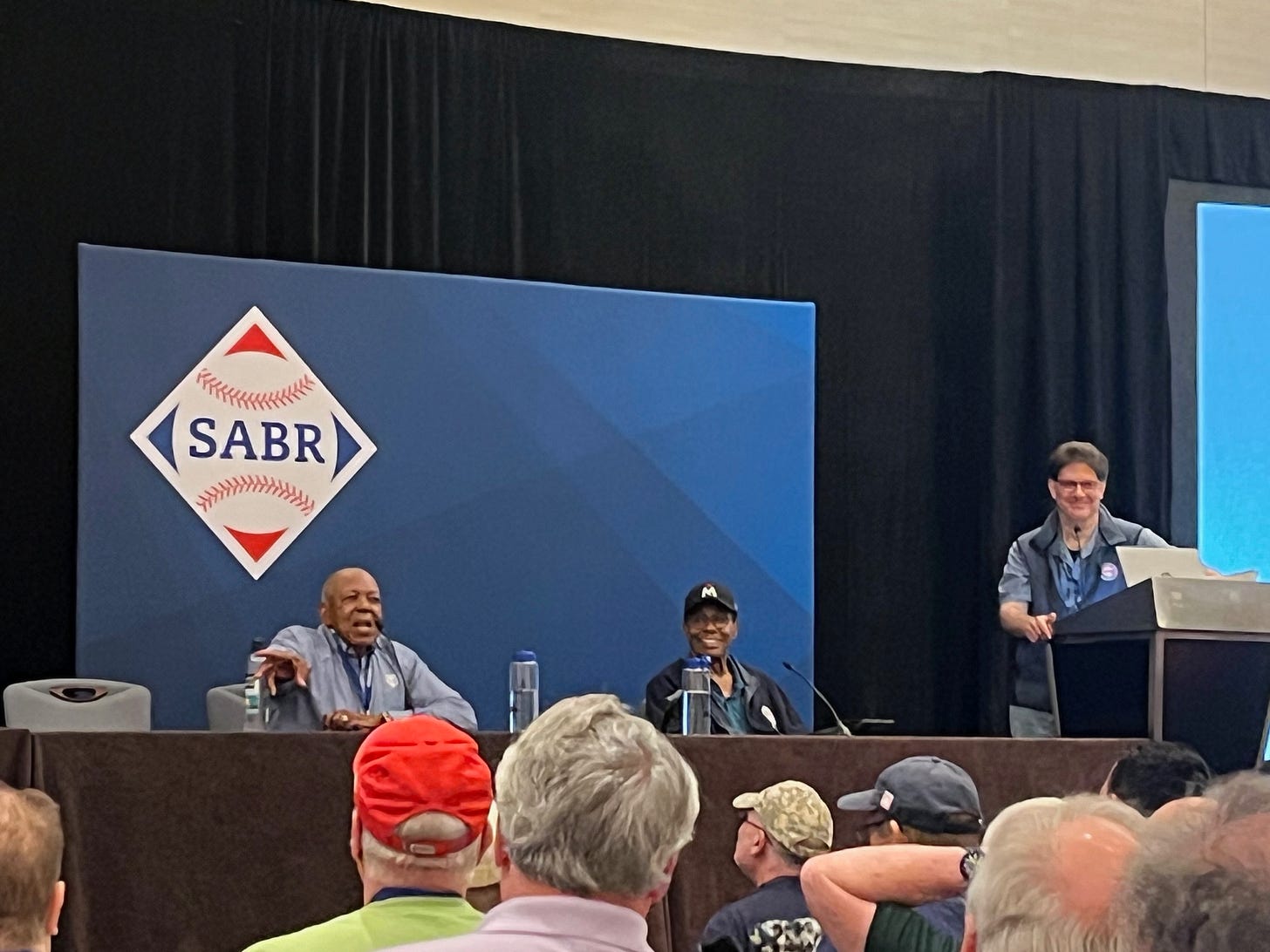

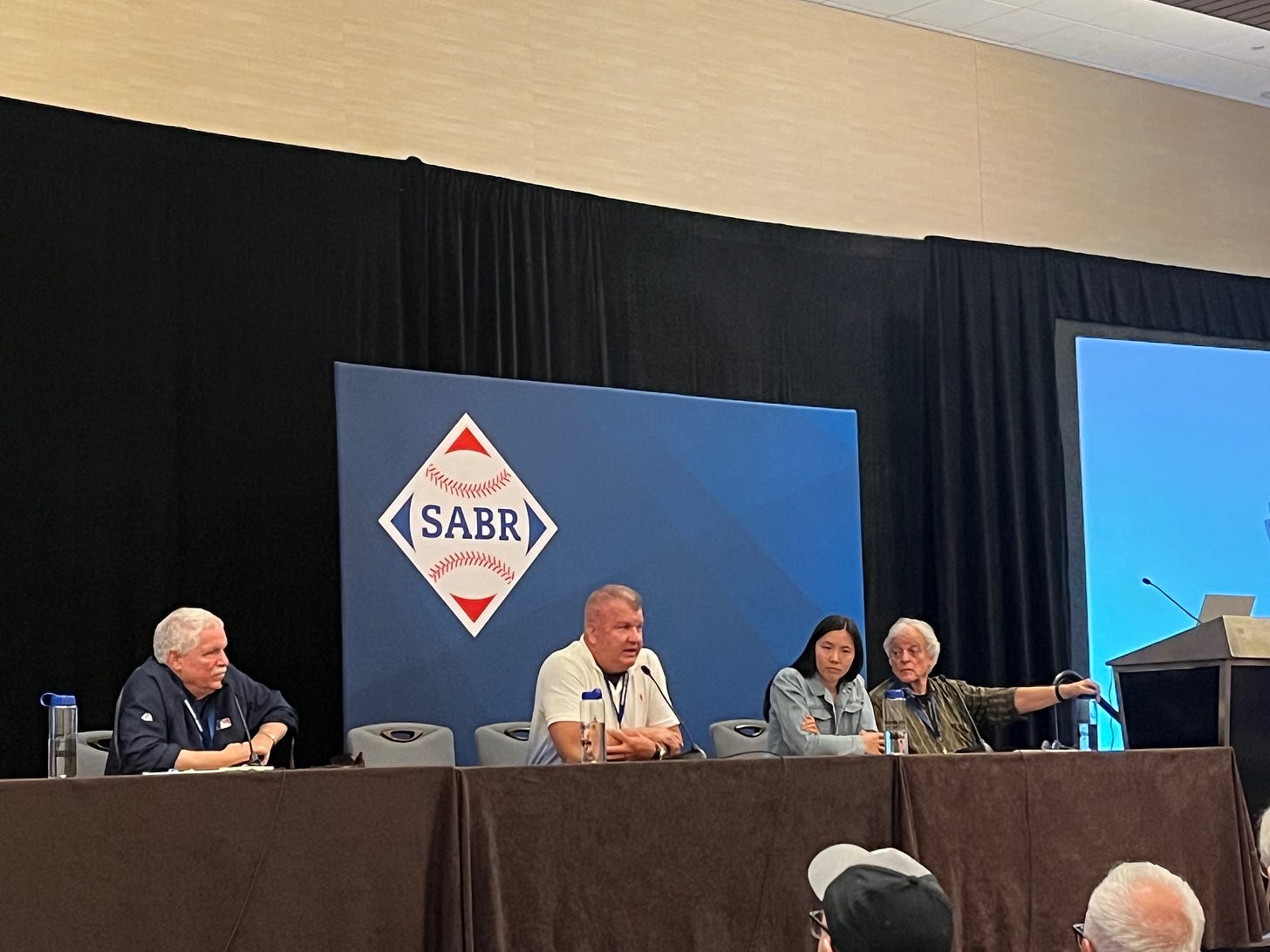
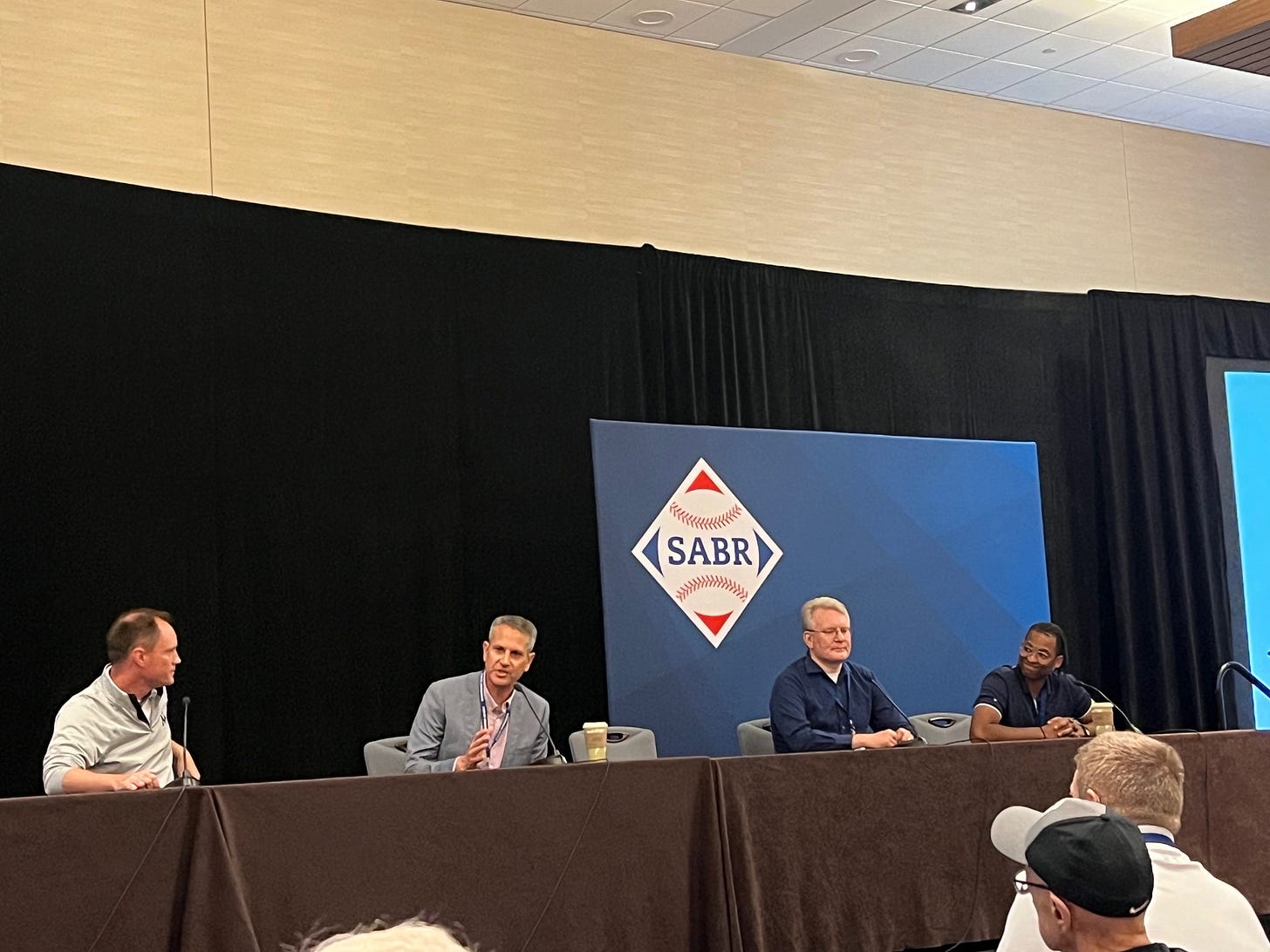
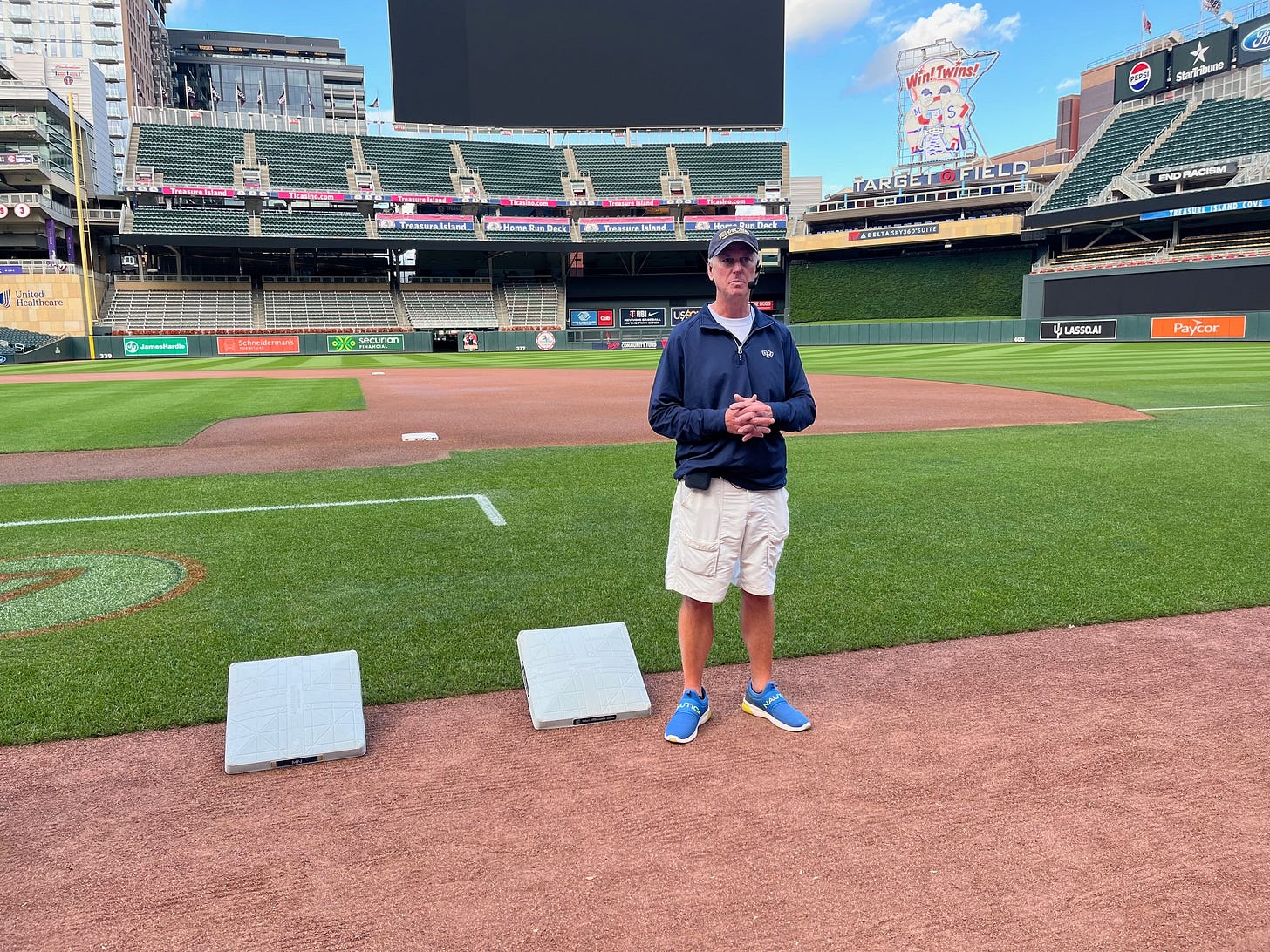
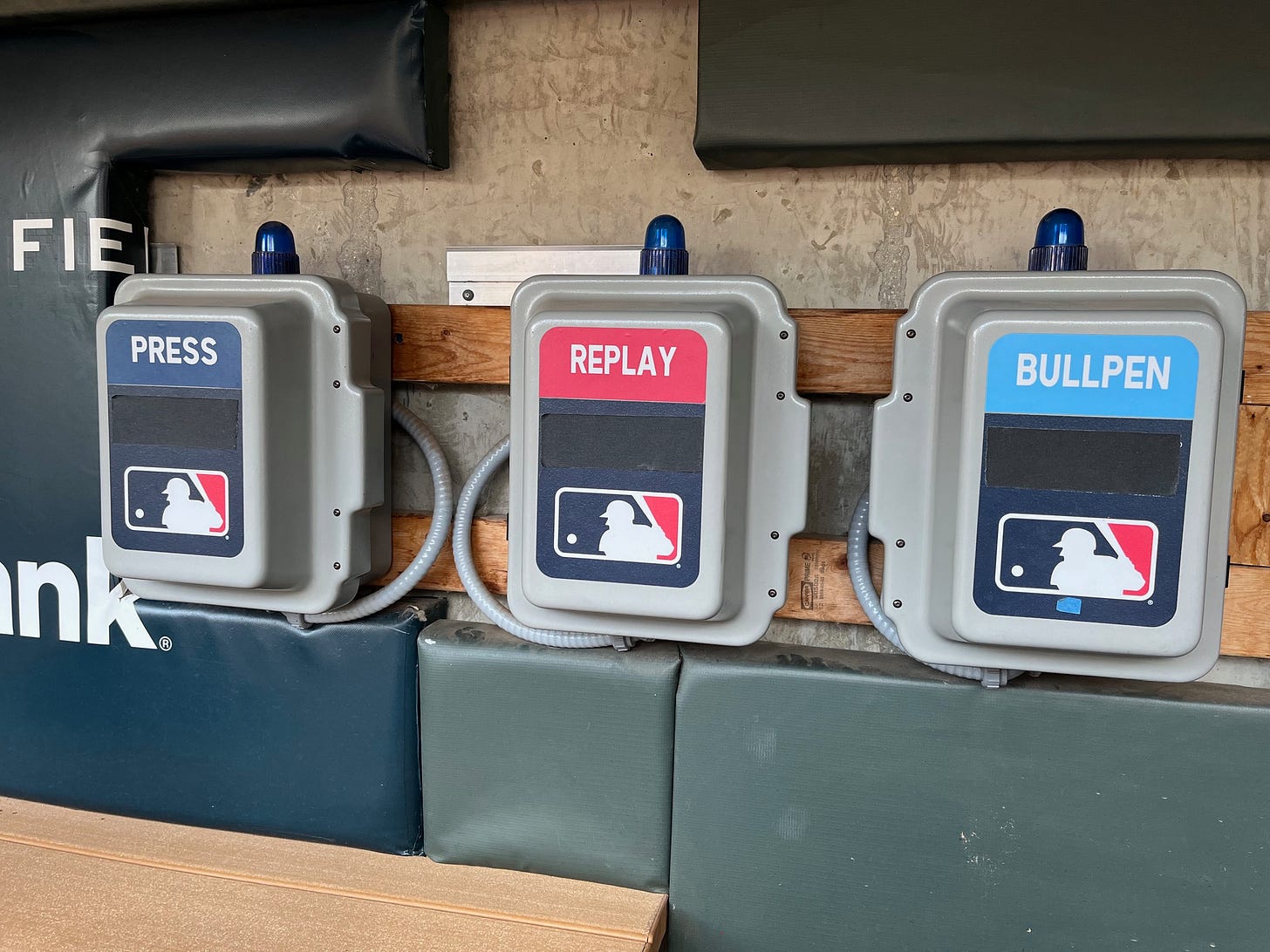
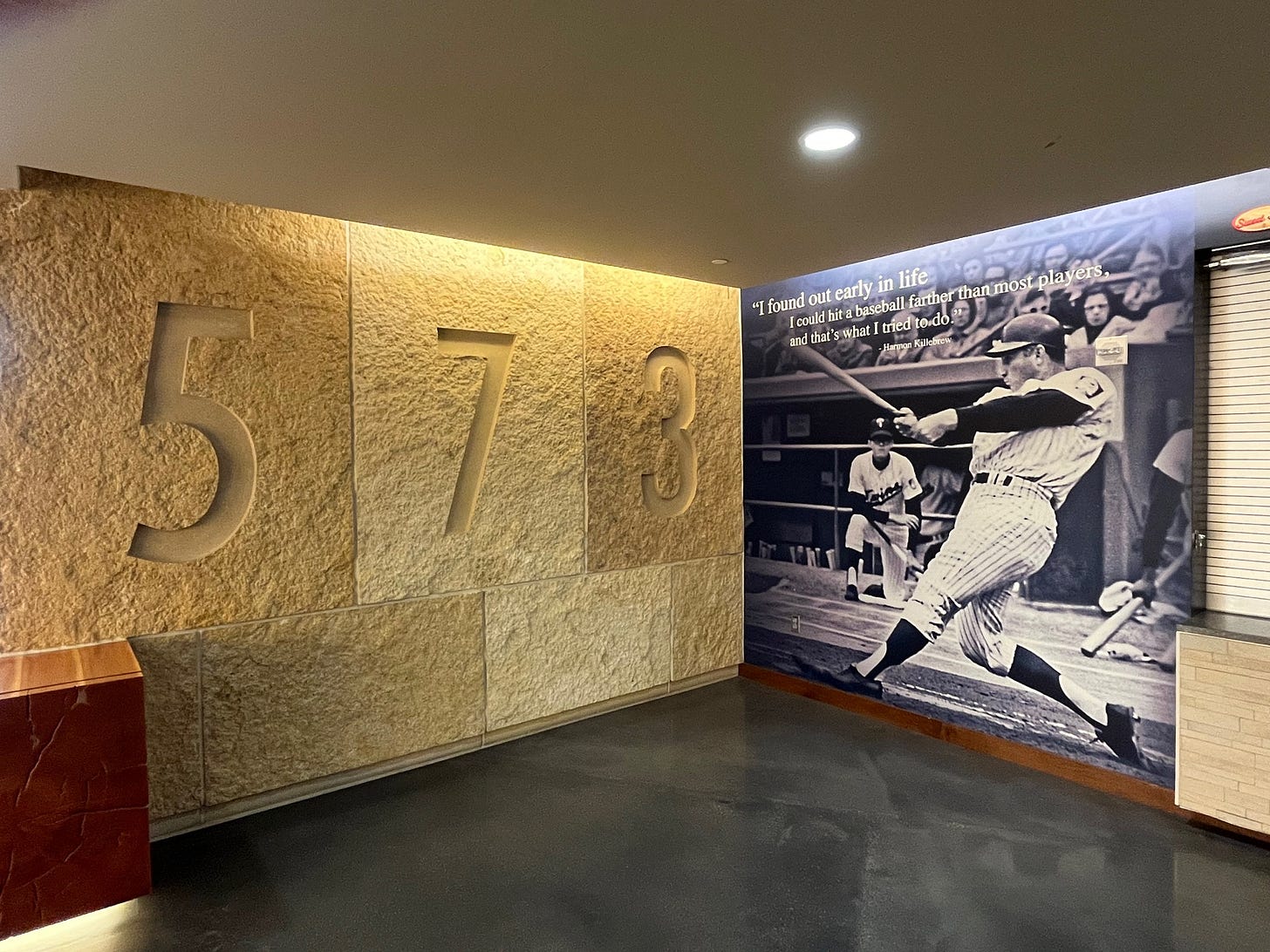
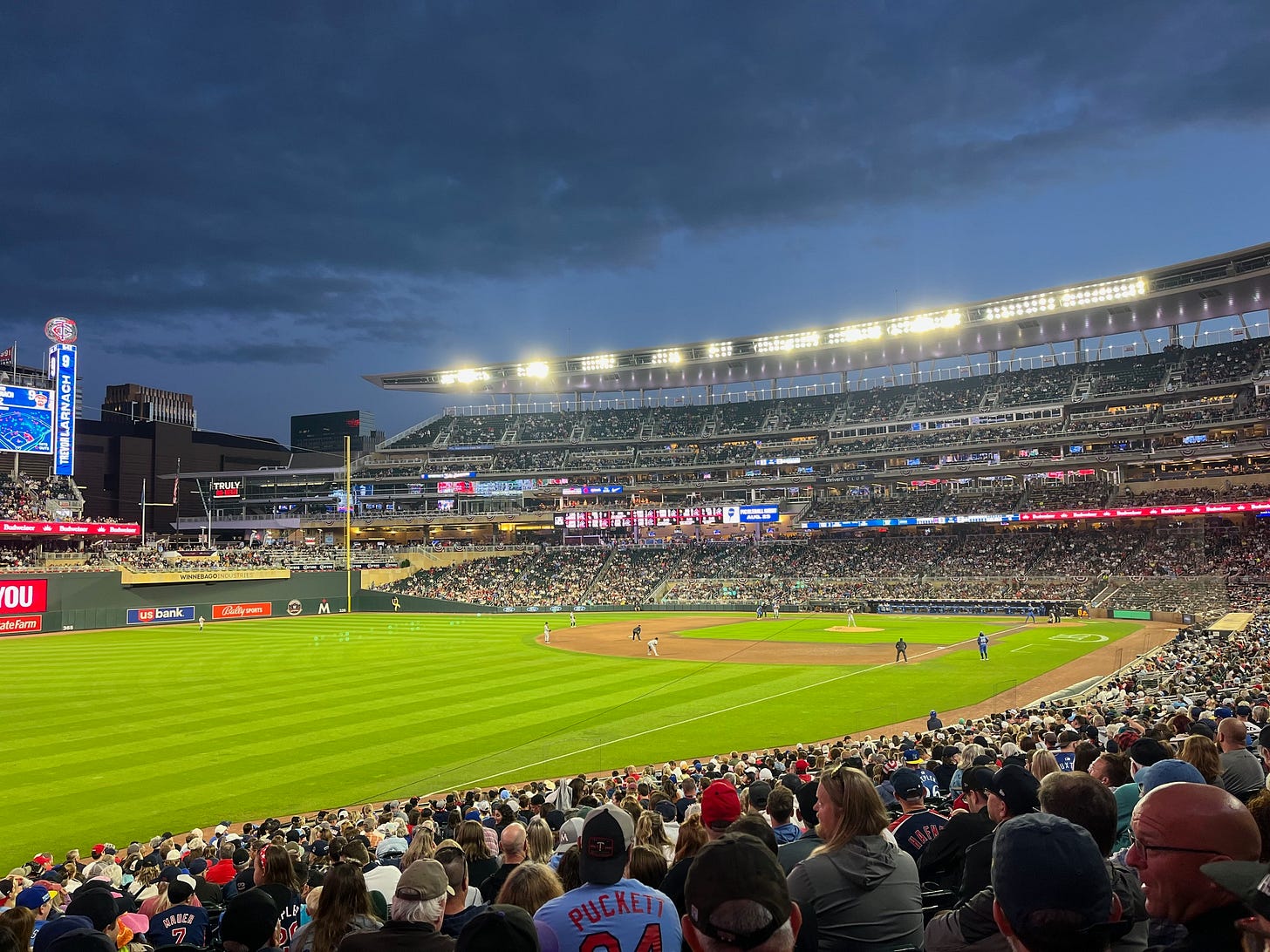
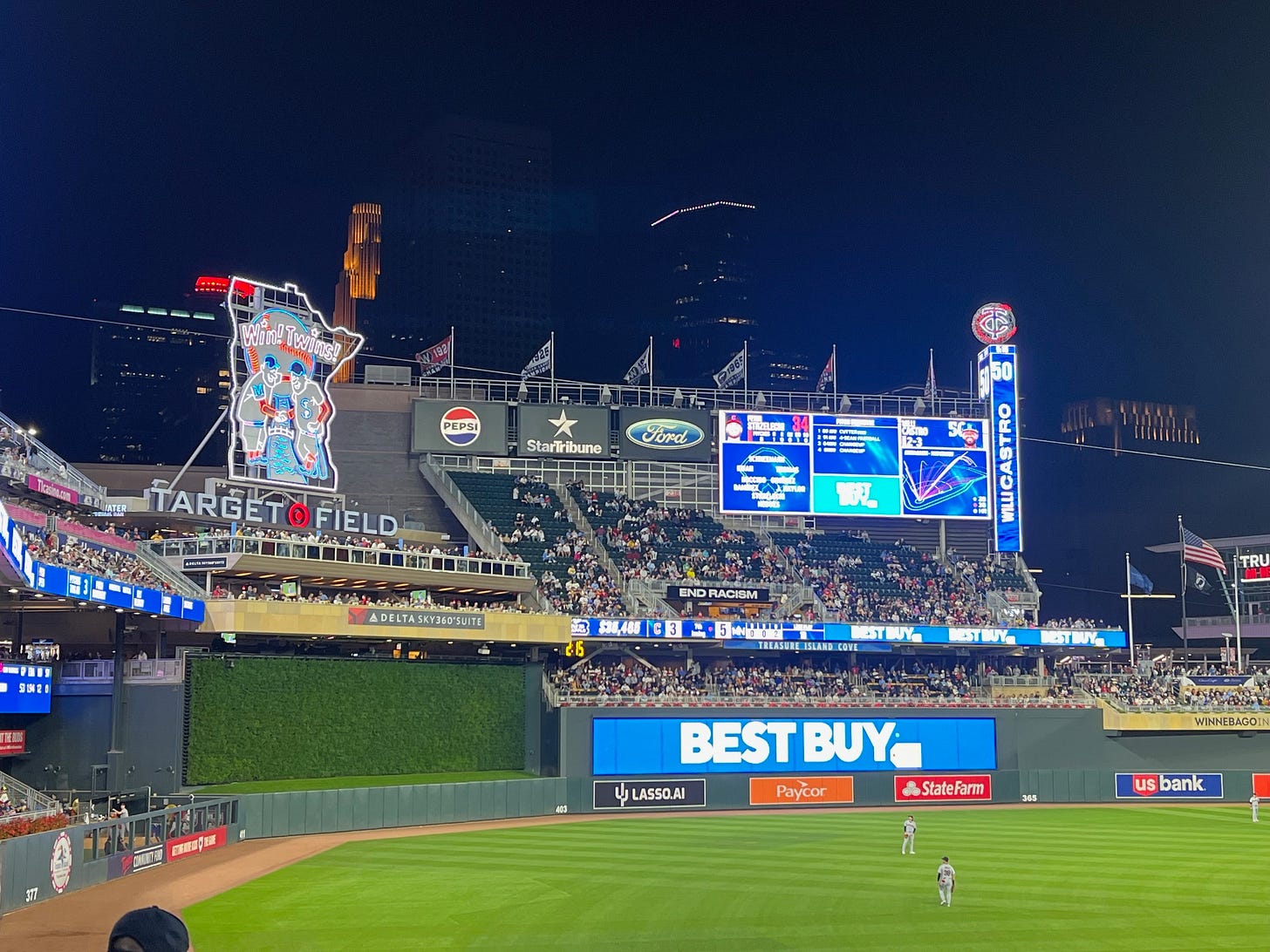
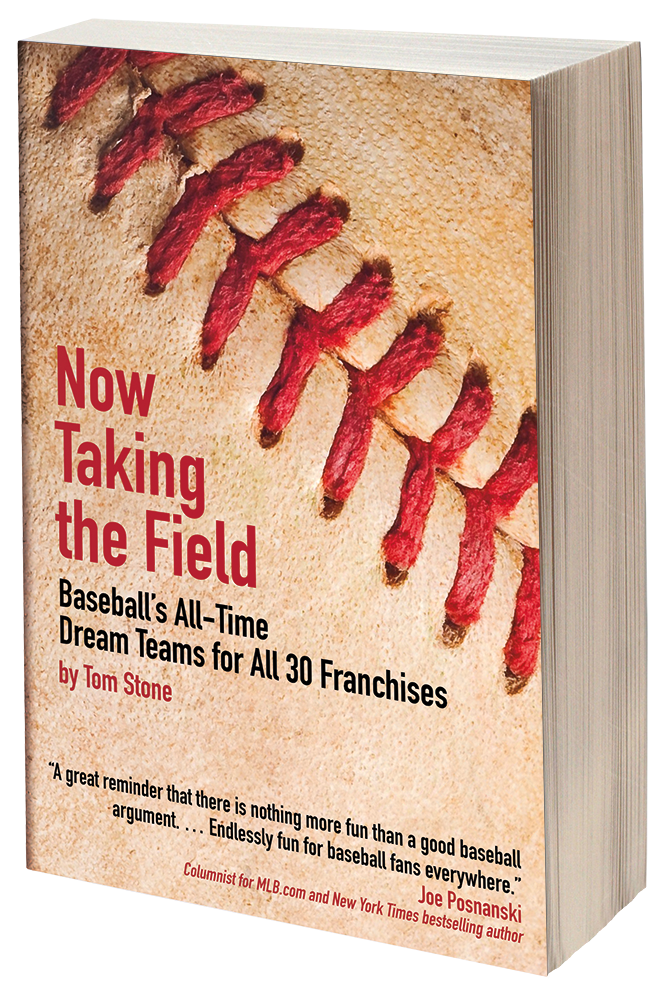
Thanks for this informative and insightful piece. I appreciated how the convention incorporates player perspective throughout and doesn’t limit scope to academic papers on baseball. Would love to go one of these in the future. It’s on my bucket list!